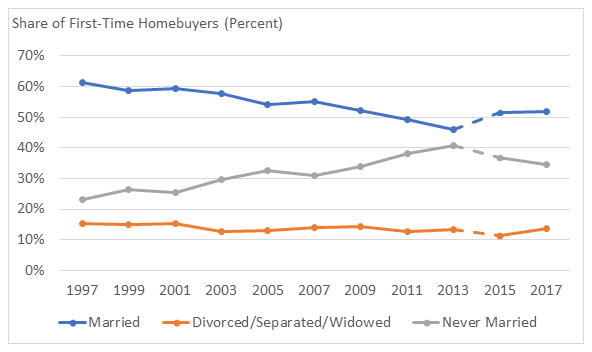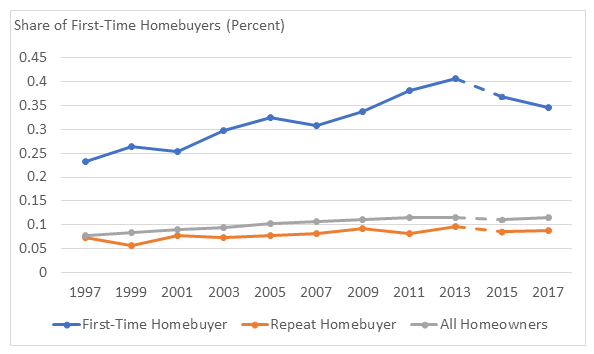New Paper Shows Substantial Changes in the Profile of First-Time Homebuyers
First-time homebuyers increasingly include never-married households and newly-formed households, according to a new working paper I co-authored with Shannon Rieger and Sean Veal. In the paper, we use the biennial American Housing Surveys (AHS) from 1997-2017 to document and discuss the profile of today’s first-time homebuyers and the extent of change over time in first-time homebuyers’ household and housing unit characteristics. Two of the clearest trends that emerge from this analysis are significant increases in the share of recent first-time homebuyers that have never been married and in the share that are forming new households. Taken together, these trends suggest that there may be a fundamental shift in the way that young households are approaching first-time home purchases, such as an increased willingness to purchase homes individually or with unmarried partners.
Beyond these specific findings, a primary goal of the paper is to produce and release published tables with detailed information about the household and housing unit characteristics of first-time and repeat homebuyers using the 1997-2017 AHS data. The paper is accompanied by detailed appendix tables that provide a unique resource for readers seeking information about the characteristics of first-time and repeat homebuyers. The primary limitation, however, is that the AHS implemented a redesign in 2015 that limits the comparability of estimates across 2013 and 2015. Thus, our discussion of trends focuses on changes from 1997-2013, although the figures display estimates for all years through 2017.
While discussions of first-time homebuying often tie homeownership entry to life-stage changes like marriage and the birth of a first child, a growing share of first-time homebuyers do not fit this profile. In 2017, over half of first-time homebuyers were married (52 percent), but 35 percent of first-time homebuyers were never married, 11 percent were divorced or separated, and 3 percent were widowed.
Moreover, tracking these figures over time reveals a clear shift from married households to never-married households (Figure 1). The married share of first-time homebuyers declined from 61 percent in 1997 to 46 percent in 2013. This decline is offset by an increase in the never- married share from 23 percent in 1997 to 41 percent in 2013. Over the same period, the share of first-time homebuyers who reported being divorced, separated, or widowed hovered between 13-15 percent in all years. Because the trends in marital status are not mirrored by similarly-large shifts in the age distribution of first-time homebuyers, it is unlikely that they are driven by demographic shifts like decisions to delay marriage and childbirth until later ages. Similarly, while this increase preceded the landmark Obergefell v. Hodges decision legalizing gay marriage throughout the United States, the magnitude of the shift is too large to be fully explained by an increase in homeowners that were same sex couples.
Figure 1: Marital Status of First-Time Homebuyers by Year
Note: The redesign of the American Housing Survey in 2015 complicates comparison of estimates between 2013 and 2015. Conversely, AHS sample and survey consistency permits reliable comparisons for 1997-2013 and 2015-2017.
Source: Tabulations of US Census Bureau, 1997-2017 American Housing Surveys.
Instead, this shift may reflect broader changes in approaches to homeownership, such as an increased willingness to purchase homes individually or with unmarried partners. Figure 2 shows that this increase substantially outpaces the shifts observed among repeat homebuyers and among all US homeowners during this period. While the never-married share of repeat homebuyers and all homeowners increased by 2 percentage points and 4 percentage points, respectively, between 1997-2013, the never-married share of first-time homebuyers increased 17 percentage points during this period. While it subsequently declined somewhat in the redesigned 2015 and 2017 surveys, the change in the never-married share of first-time homebuyers from 1997-2017 still dramatically outpaces the shifts among repeat homebuyers and all homeowners.
Figure 2: Never-Married Share of Households by Year and Homebuyer Type
Source: Tabulations of US Census Bureau, 1997-2017 American Housing Surveys.
First-time homebuyers’ formation of new households also exhibits a clear trend that may reflect a more fundamental shift in the way younger people approach first-time home purchases. In 2017, 79 percent of first-time homebuyers were living in existing households—defined as those for whom the prior home was rented by someone in the current household (i.e. renter households that remained intact as they transitioned from renting to owning). Conversely, 21 percent of first-time homebuyers formed a new household at the time of home purchase, including 12 percent who previously lived with a homeowner and 8 percent who previously lived with a renter.
The share of first-time homebuyers who were newly-formed households increased markedly from 12 percent in 1997 to 26 percent in 2013, suggesting that more first-time homebuyers than in the past are simultaneously making changes to their household composition. One possible contributor to this trend is that the rise in adult children living with their parents may be increasing the number of first-time homebuyers transitioning straight from such living arrangements to homeownership. However, other explanations are possible as well.
Figure 3: Household Formation of First-Time Homebuyers by Year
Source: Tabulations of US Census Bureau, 1997-2017 American Housing Surveys.
Detailed analyses of these trends to identify causal contributors and to decompose the relative contributions of alternative factors is beyond the scope of the analysis in the paper, which seeks only to document the characteristics of first-time homebuyers and to describe trends over time. But in both cases, the size of the changes over the past decade indicate that the shifts are widespread, suggesting that they merit the type of detailed analyses that might shed light on the various factors contributing to these shifts.




